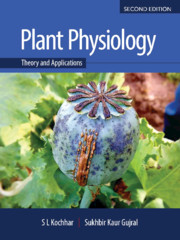Book contents
- Frontmatter
- Contents
- Foreword
- Preface to the Second Edition
- Preface to the First Edition
- Acknowledgements
- Some Common Abbreviations used in the Text
- Abbreviations for Units
- Unit I Water and Mineral Translocation in Plants
- Unit II Metabolism and Bioenergetics
- Unit III Growth and Development
- Unit IV Physiological Stress and Secondary Metabolites – Their Role in Metabolism
- Unit V Crop Physiology – An Innovative Approach
- Unit VI Breakthroughs in Plant Physiology
- Unit VII Some Experimental Exercises
- Glossary
- References
- Index
- Colour Plates
Chapter 16 - Plant Hormones and Signal Transduction
Published online by Cambridge University Press: 12 May 2020
- Frontmatter
- Contents
- Foreword
- Preface to the Second Edition
- Preface to the First Edition
- Acknowledgements
- Some Common Abbreviations used in the Text
- Abbreviations for Units
- Unit I Water and Mineral Translocation in Plants
- Unit II Metabolism and Bioenergetics
- Unit III Growth and Development
- Unit IV Physiological Stress and Secondary Metabolites – Their Role in Metabolism
- Unit V Crop Physiology – An Innovative Approach
- Unit VI Breakthroughs in Plant Physiology
- Unit VII Some Experimental Exercises
- Glossary
- References
- Index
- Colour Plates
Summary
Hormones are naturally occurring molecules, in plants and animals that function as messengers and signalling agents and thus impact growth and behaviour of the organism.
Plant hormones are classified as being of five major types: auxins, gibberellins, cytokinins, abscisic acid and ethylene (Table 16.1). Besides these plant hormones; various compounds such as salicylic acid, jasmonates, polyamines, strigolactones, brassinosteroids and nitric oxide (NO) have been reported to act as signalling molecules in hormonal and defence responses.
Auxin: The Growth Hormone
Historical background
The way auxins were discovered is quite fascinating and deserves a special discussion because it was the first and foremost growth hormone to be discovered in plants (Figure 16.1).
In later years of his career, the great evolutionary biologist Charles Darwin became increasingly interested in the study of plants. In 1881, Darwin along with his son Francis authored a book called ‘The Power of Movement of Plants’ in which they highlighted a series of experiments on the growth response of plants to light – Phototropism. For their experiments, they used germinating oat (Avena sativa) and canary grass (Phalaris canariensis) seedlings. Both the Darwins found that if seedlings were exposed to light from one direction, they would bend strongly towards it. If the coleoptile tip was covered with foil, it would not bend. The zone of coleoptile responsible for bending toward the light – ‘the growth zone’–is many millimetres below the tip. Thus, they came to the conclusion that some kind of stimulus produced in the tip region travels to the growth zone and causes the non-illuminated (shaded) side to grow more quickly compared to the illuminated side. For 30 years, the Darwin's experiments remained the only source of information about this interesting phenomenon.
Later in 1913, the Danish plant physiologist Peter Boysen-Jensen and the Hungarian plant physiologist Arpad Paal (1919) independently proposed that the growth-promoting signal generated in the tip region was chemical in nature.
They decapitated the coleoptile of Avena seedling and in one experiment (a) inserted a small gelatin block between the stump and cut tip and in other (b) a thin sheet of mica. The coleoptile bending was observed in (a) but not in (b) because the growth stimulus passes across the gelatin block but not through a water-impermeable barrier such as the mica sheet.
- Type
- Chapter
- Information
- Plant PhysiologyTheory and Applications, pp. 468 - 525Publisher: Cambridge University PressPrint publication year: 2020



